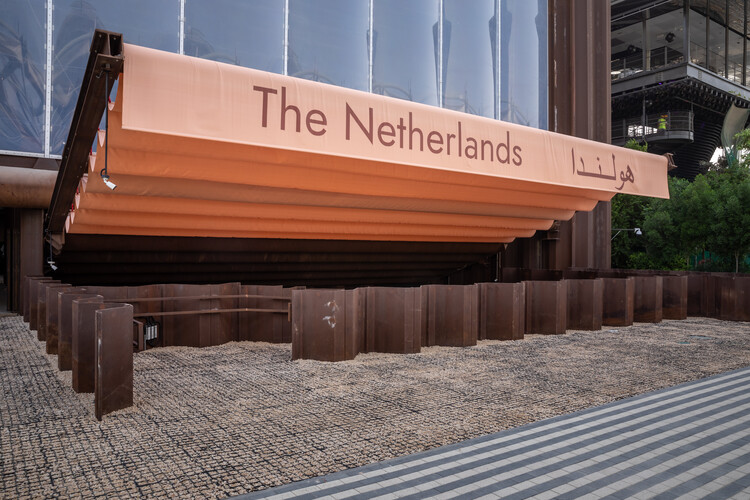
The Netherlands Pavilion at Expo 2020 Dubai proposes a circular climate system that harvests water, energy, manufactures rain and produces food, creating a temporary biotope that embodies the fusion between art, architecture and technology. Designed by V8 Architects, with a visitor experience curated by Kossmanndejong, the pavilion creates a multi-sensory narrative around natural phenomena. Industrial materials like metal sheets, steel tubes, ducts and pipes blend unexpectedly with vegetation and textile fabrics to create a spatial journey culminating in a centrepiece that provides a tranquil stop amidst the bustle of the Expo.

The project is a display of experimental solutions to “water scarcity, energy transition and food shortages on a life-sized scale model.” Inside the pavilion, a large cone is the main element of the exhibit- a vertical farm covered in edible plants on the outside and mushrooms on the inside. The chimney-like structure helps regulate temperature and moisture inside the cone. Water is harvested from air humidity and used for plant irrigation, with the pavilion extracting 800 litres of water daily.
The process is powered by renewable energy obtained through lightweight, organic transparent solar cells or OPV designed by artist Marjan van Aubel.

Visitors descend into the pavilion on a ramp and start experiencing the shift in temperature. Reinforcing the machine metaphor is the control room that leads inside the central cone where the technical innovations of the pavilion can be seen projected onto white umbrellas. After experiencing the microclimate of the cone and a choreographed rainfall, they take in view the plant-covered structure, and upon exiting, they are met with a scent installation that recreates the smell of Dutch soil created by Birthe Leemeijer.
The textiles featured inside the pavilion are made of biopolymers created from corn starch, while the floor tiles are made of bio-mass material containing mycelium. Embodying the principles of the circular economy, the pavilion is designed for disassembly and reuse. The raw construction materials, a nod to Dutch civil engineering tradition, will be returned to their local owners, while the biomass elements will return to nature.




























